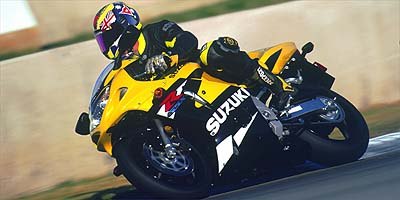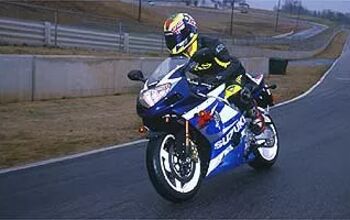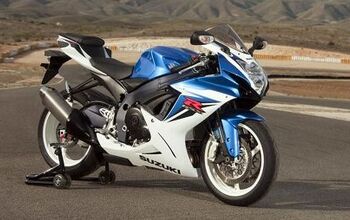2001 Suzuki GSX-R600 - Motorcycle.com
Atlanta, Georgia, October 20, 2000 -- The first lap of any new track is always interesting, but the first time around Road Atlanta aboard Suzuki's new GSX-R600 was eye-opening: We heard a lot about the track and the bike, but at the beginning of the day, the possibility of being able to fully appreciate either -- as they deserved -- seemed a daunting task.
Though we had seen the track on television -- and Editor Plummer had raced there long ago -- there are new elevation changes and many blind corners, we were overwhelmed by just how much the elevation changed and how blind the corners were. Freddie Spencer had said that there were only two tracks in the US that are truly difficult to negotiate: Road Atlanta is one of them.
We also heard how significantly-changed the new GSX-R600 is. As the technical information indicates, it is not only lighter, but it is more powerful as well. It not only got an entirely new chassis, it also received GSX-R750-inspired bodywork whose outward appearance only hints at the performance lurking underneath. It only took a few twists of the throttle and a few rolls through some corners to realize we have a whole new beast on our hands.
As we confirmed in last year's World Supersport Shootout, Suzuki's GSX-R600 was no slouch, really. It's just that Suzuki had not updated the GSX-R600 as recently as its competitors.The first impression of the new bike is similar to lifting a five-gallon gas can that you expect to be full -- but it's not.
Granted, pulling out of the pits and onto the track, the steering damper (like the one on the 750) makes the bike feel heavier than it is. But, once above 20 mph and especially when you flick the bike into a bend, it feels as if the bike has lost more than the claimed 25-pounds. Though not back-to-back, the new bike still feels a bit wider through the midsection than Yamaha's ultra-svelte YZF-R6.
Through the corners, it's a different story. The GSX-R has the same sort of precision that the 750 exhibited during our Open Sportbike Shootout. In similar fashion to its larger sibling, the handling characteristics of this GSX-R are incredibly neutral.Even with the bike leaned over through the gnarliest corner, we always were able to pick the bike up with our knee when it started drifting out. Then we'd bring it back down into the corner with little more than a thought. This includes turn seven, which consists entirely of pavements patches and seams.
Through the bumpiest corners the suspension soaked up everything it was asked to deal with despite the stock settings. This meant that we had, at once, compliance and the sort of feedback which usually comes with only stiff and rigid racetrack-only settings. The bike did move around a bit through a particular 160 mph sweeper that was littered with pavement irregularities, but what bike wouldn't? A little bit of dialing for strict track use and we think you'd be hard pressed to find a better chassis.
With the excellent chassis making sure the rider stays planted on the seat and not on a gurney in the back of a red and white Ford Econoline with flashing lights, the rider is safe to twist the throttle on the newly empowered motor. Fitted with a fuel-injection system similar to that of the GSX-R750, the throttle response is as impressive as is the power on tap.Power flows long and hard from 9,000 rpm up, but there's not much below that. On the track, this is not a problem. Proper gear selection will keep the mill boiling and producing the type of class-leading numbers that make engineers summon wry smiles and swell with pride when performance-based bonus checks come in the mail.
Below that 9,000 rpm mark however, there are bikes with more midrange, Kawasaki's ZX-6R, for instance. Still, no other 600 in memory conjures up such vivid tire-spinning mental images.
Coming out of turns five and seven, you encounter rises in the road that some 600 supersport machines can carry their front wheel over. We had to lay our upper body flat against the tank to keep the Suzuki on the ground. A bit more preload in the rear may make it easier to keep the front end grounded, but slight alterations in riding position kept things settled enough for our purposes.When it was time to slow down, we found the brakes to be superb. Coming down the hill into turn nine, braking from more than 150 mph, one finger is all it takes to get the bike to stand on its nose. There's enough feel present at the lever that you're never worried about losing the front end while you're braking, either. This fact alone begged for deeper corner entries every lap, yet not once all day did any of us find ourselves out and about among the kudzu.
This bike was built for racetrack domination first and foremost. And in that context, the other manufacturers are going to have one hell of a battle on their hands this year.
Will it be enough to hold off the sharpened Yamaha and Honda? And don't forget the Kawasaki and Ducati are no slouches, either. If first impressions mean anything, all bets are off the table until we get all contenders to the racetrack, backroads and dragstrip for our Year 2001 World Supersport Shootout.
More by Motorcycle Online Staff


















![Inside Look at the 2011 Suzuki GSX-R600 [video]](https://cdn-fastly.motorcycle.com/media/2023/05/07/11554789/inside-look-at-the-2011-suzuki-gsx-r600-video.jpg?size=350x220)














Comments
Join the conversation